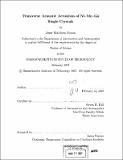Transverse acoustic actuation of Ni-Mn-Ga single crystals
Author(s)
Simon, Jesse Matthew
DownloadFull printable version (9.115Mb)
Other Contributors
Massachusetts Institute of Technology. Dept. of Aeronautics and Astronautics.
Advisor
Steven R. Hall.
Terms of use
Metadata
Show full item recordAbstract
Two methods for the transverse acoustic actuation of {110}-cut Ni-Mn-Ga single crystals are discussed. In this actuation mode, crystals are used that have the {110}- type twinning planes parallel to the base of the crystal. The first method employs two 33-mode piezoelectric stacks, mounted at 45 deg to the base of a single crystal, to produce a shear stress on the 110 planes. The second method utilizes a single 15-mode piezoelectric stack, normally incident to the crystal base, to generate shear pulses directly. Both methods are capable of producing acoustic actuation. Due to the small size of the 15-mode stack, and the need to prestress the 33-mode stacks to prevent them from failing due to tensile stresses, the single stack actuator was chosen for further investigation. Engineering strains of up to -y = 0.12, the theoretical maximum for Ni-Mn-Ga, have been realized in the single stack configuration. Actuating over a smaller range, the actuator produced 5% strain in as little as 2.5 s, at a pulse frequency of 100 Hz, with over 3% occurring within the first second. Actuation against a load was also investigated. The blocking stress was found to be around 0.14 MPa, indicating that the acoustic stress exceeded the twinning stress by approximately this amount. (cont.) The maximum output energy density of the actuator was approximately 4000 J/m3, for an opposing stress of 0.08 MPa. Given the electrical power consumption of the actuator, which is around 375 mW at 100 Hz, the overall actuator efficiency is approximately 4 x 10-4. Recent results for both methods are presented, including new evidence of a viscous loss mechanism that governs the strain rate of the crystal. An increase in the displacement per pulse with frequency is observed, indicating that the inertia of the moving portion of the crystal may cause it to deform even after the pulse has passed.
Description
Thesis (S.M.)--Massachusetts Institute of Technology, Dept. of Aeronautics and Astronautics, 2007. Includes bibliographical references (p. 89-92).
Date issued
2007Department
Massachusetts Institute of Technology. Department of Aeronautics and AstronauticsPublisher
Massachusetts Institute of Technology
Keywords
Aeronautics and Astronautics.